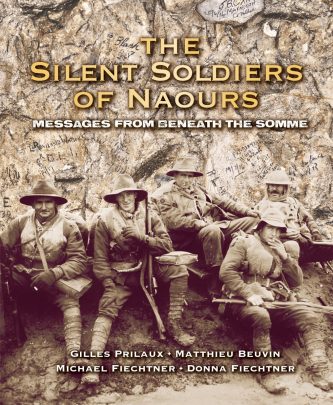The forgotten stories of Australian troops – rediscovered in the caves of France

A book with a worthy story to tell, and a heartfelt request for assistance.
He was so young, aged just 19 years, five months and five days when he died, with his life bookended, in a way, by two French memorials perhaps 40 or so kilometres apart. BAKER, Horace Frank Charles, gardener, of Brighton Road, New Glenelg in South Australia, is one of the Aussie soldiers honoured in a book, The Silent Soldiers Of Naours, A joint French-Australian effort, it is compiled by archaeologist Gilles Prilaux, scientist Matthieu Beuvin, and Australian husband and wife educators, Michael and Donna Fiechtner.
Horace Baker is one of those featured because he bivouacked near the town of Naours where, on 13 July 1916, he wrote his name in pencil on a wall in the town’s vast underground catacombs. He died at Pozieres 40 days later, his body never recovered. He is remembered today with his name recorded on a second wall just a few kilometres away from the first, on the Australian Memorial at Villers-Bretonneux.

There are many times on reading this book that the hackles rise and an icy cold sensation passes through the reader’s body. One of the most poignant moments is reading a copy of the letter from Horace Baker’s father, “Will you kindly forward a… certificate of the death of my son…” Multiply that by 46,000 and you get an idea of the huge loss a young country such as ours bore.
But what is Naours, other than a pretty little village in Picardy, in northern France? Its claim to modern fame has to do with a mine. In 1886 an abbott, Ernest Danicourt, read, “When the Normans desolated our countryside… the inhabitants of Naours dug the vast and beautiful quarries… to retire there with their wives, children and cattle.” Questioning elderly locals, the priest managed to find an entrance to the underground quarries which had been sealed for 60 years. Within two weeks, with the help of young parishioners, he cleared an opening and was able to enter, continuing excavations over the next two decades. His records from that time provide the most complete plan of the caves because one-third of the system is no longer accessible.

It is an immense network, with streets extending 2,000 metres in length, spread out like a well-planned town containing 28 galeries and 300 chambres, and was accessible to soldiers passing through the Naours waypoint on their way to Amiens.
Let’s return for a moment to Horace Baker, his story being common to so many: After evacuation from Gallipoli and retraining in Egypt, he was shipped to France in March 1917. He and his battalion fought at Armentieres and the Somme before marching to a billet at Naours for four days from 12 to 16 July. The young lance-corporal, as did many another soldier, entered and explored the labyrinth, writing his name on a wall where it was found again almost 100 years later.
The modern work in preserving the graffiti began as recently as 2014. Gilles Prilaux says it raised a lot of questions and he had no idea how far investigations would take him. “The fragile traces left by these Australian soldiers are poignant because many died within days. I imagine (they) came for an ounce of peace and to get away from the tumult of the front.” A great deal of preservation work has already been done but much more remains. Prilaux and his team, to which he enlisted the assistance of French high school students, continues its research. The team, in 2018, will be joined by children from Kepnock State High School in Queensland. One of the dreams is for Australian and French students one day to deliver a copy of each individual signature to any surviving relatives.
Michael and Donna Fiechtner, in their Acknowledgement at the front of the book, make a plea, “If you can assist by helping us identify descendants of the soldiers of Naours, please let us know.” They provide two contacts for those who may be in a position to do so via www.interculturalconsultinggroup.com
The Silent Soldiers of Naours is replete with superb photographic reproduction. It tells the story of 46 Australian servicemen who left their mark in the deep, dark interior of an excavated French complex. They are but a few of those whose passage is only now coming to light through the dedicated effort of scientists and schoolchildren. It behoves us to do anything we can, if able, to further the work of those involved in the research.
My book of the year-to-date.
The Silent Soldiers of Naours, compiled by archaeologist Gilles Prilaux, scientist Matthieu Beuvin, and Australian husband and wife educators, Michael and Donna Fiechtner is available now from Dymocks. Click here to learn more.








 Proudly Australian owned and operated
Proudly Australian owned and operated